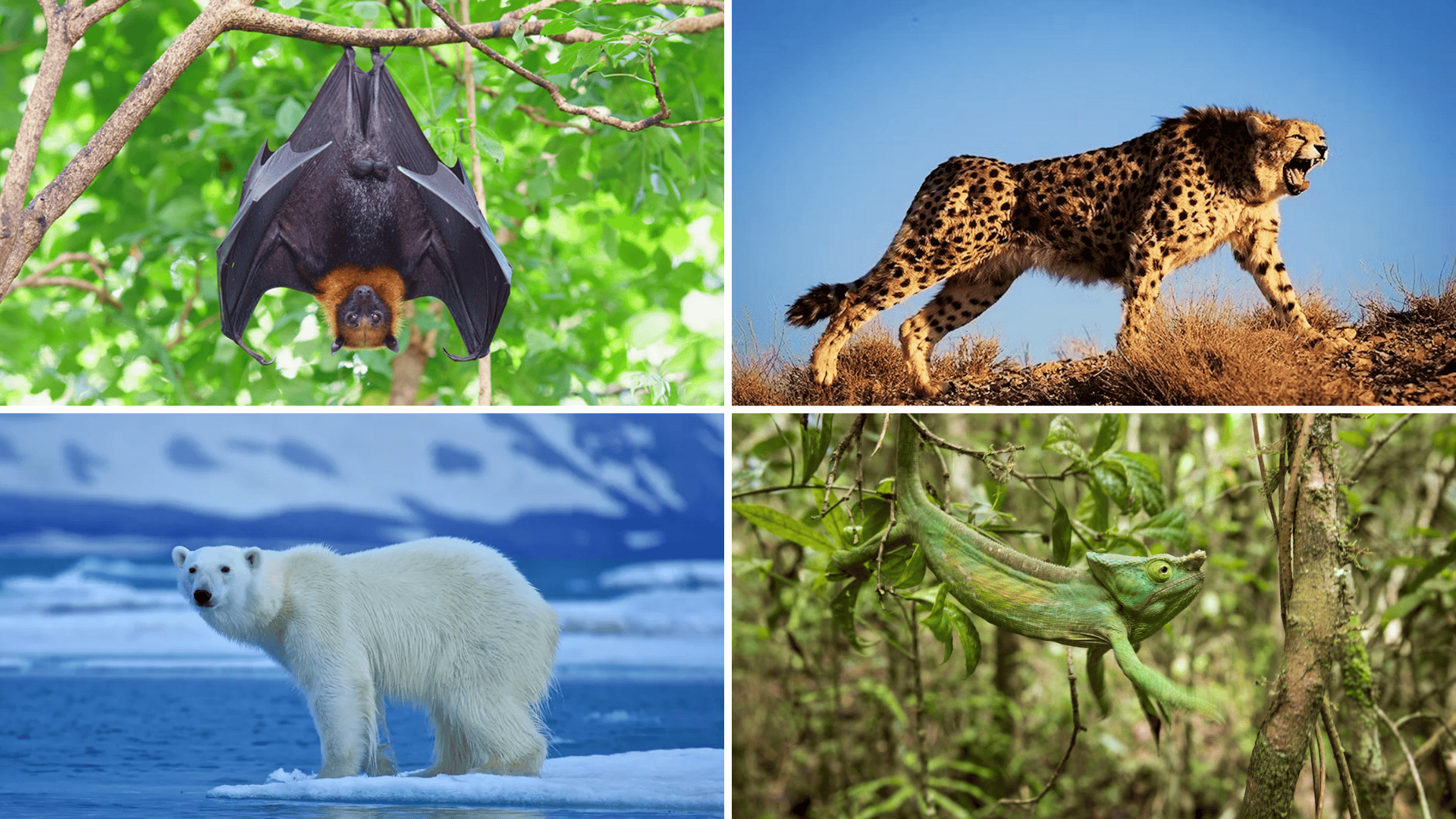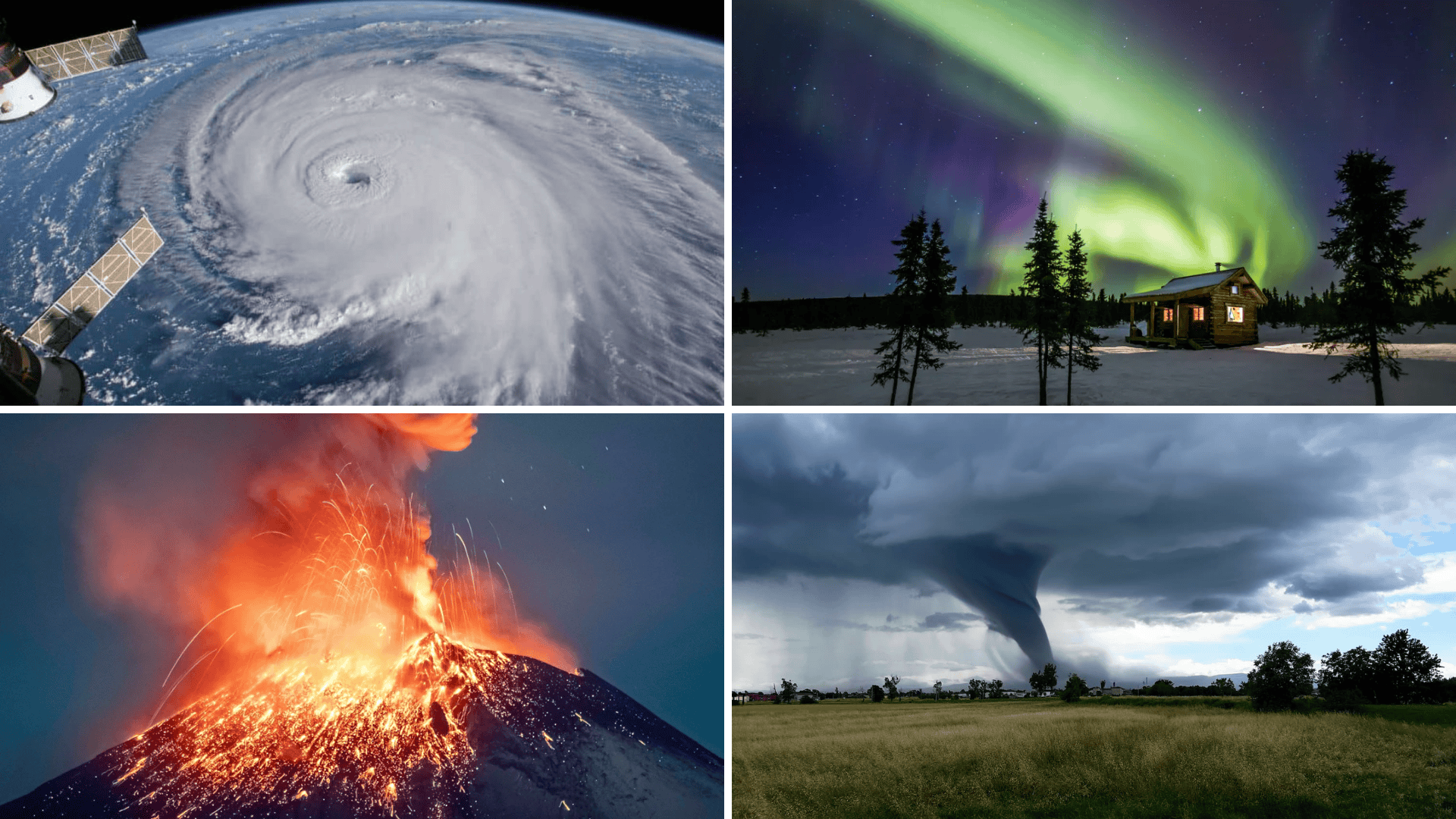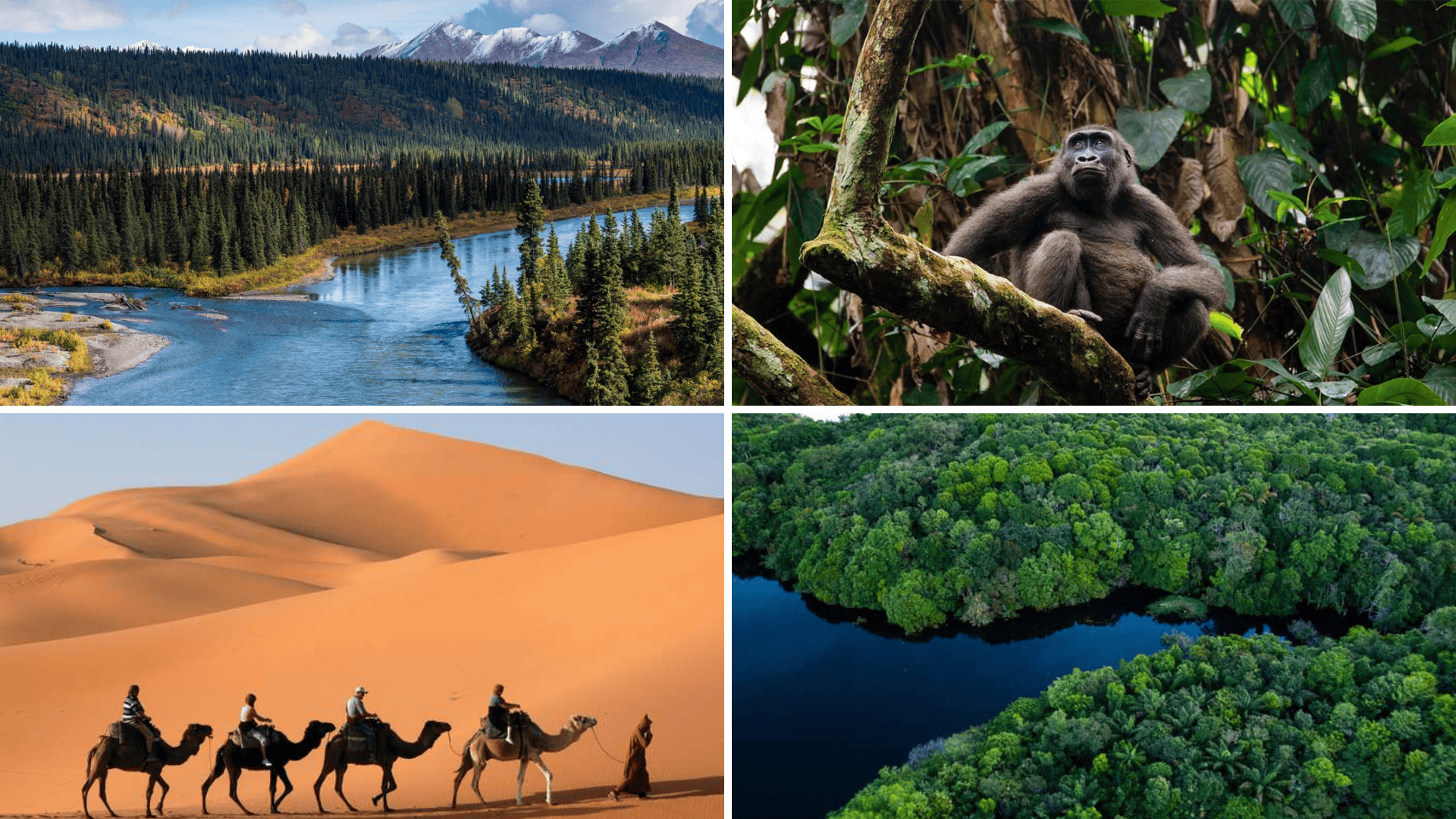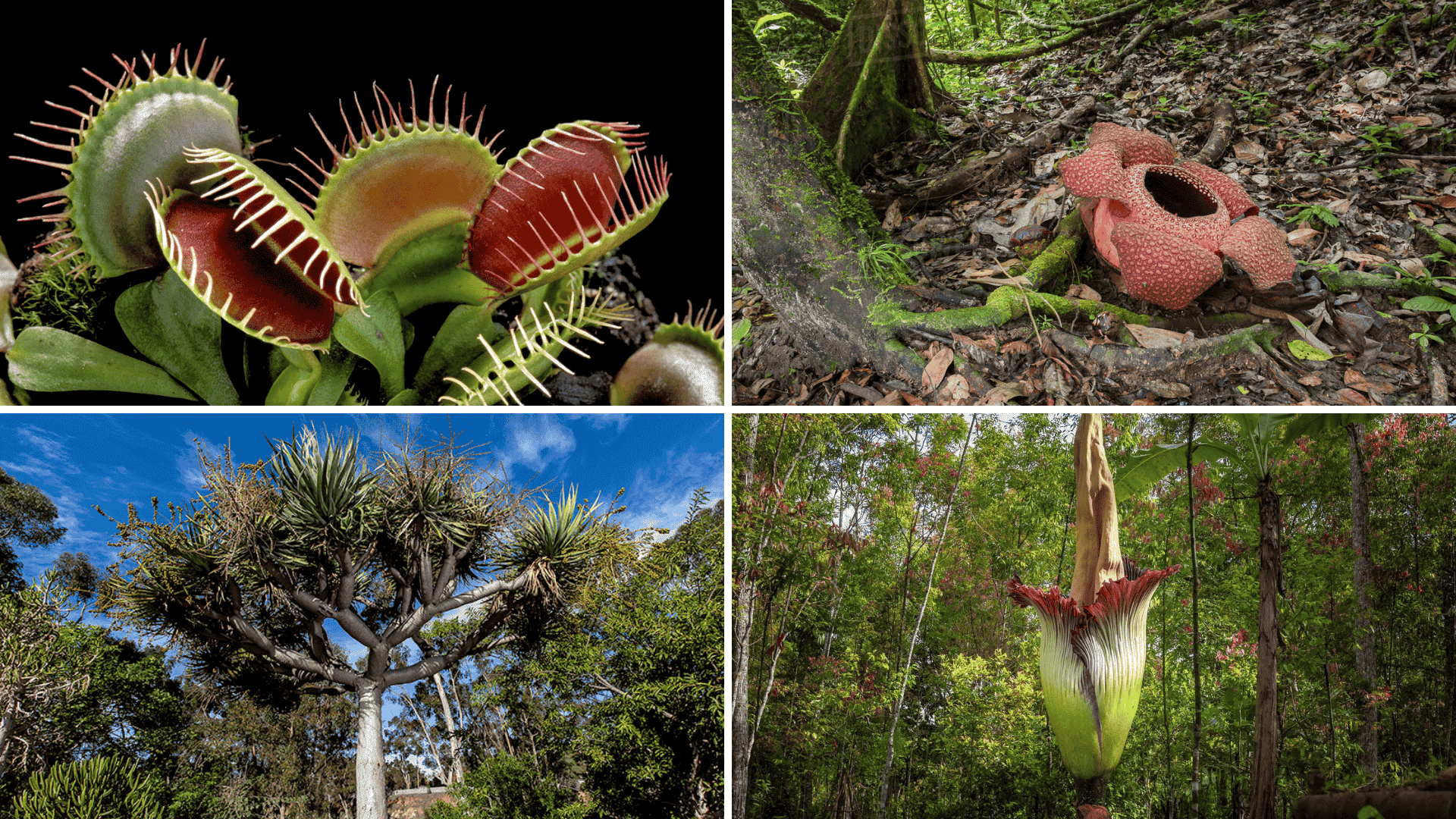All around the world, animals and plants are doing incredible things.
A lizard can change its color to blend in. A flower can make a sweet smell to attract bugs. And there’s a tiny fish out there that’s smaller than your fingertip!
These are real things happening every day in nature, not just stories from books or movies.
Get ready to learn some fantastic and strange facts about animals, plants, and places on Earth that will blow your mind.
Facts About Animal Adaptations
Here are some insights into animal adaptations, highlighting traits that enable species to survive, thrive, and flourish in various environments.
1. Chameleons’ Color Change
Chameleons are known for their ability to change color, which enables camouflage, communication, and temperature regulation.
Their skin contains specialized cells called chromatophores that help them alter their hue.
Fun Facts
- Chameleons don’t change color based on mood, contrary to popular belief.
- Their eyes can move independently, providing a wide field of vision.
- Some chameleons can change color in just a few seconds.
- They also use color change to attract mates.
2. Cheetah’s Speed
Cheetahs are the fastest land animals, capable of reaching speeds up to 75 miles per hour (120 km/h) in short bursts.
Their body structure, including a flexible spine and large nasal passages, supports their incredible speed.
Fun Facts
- Their large nostrils help provide oxygen during high-speed chases.
- Cheetahs’ claws are non-retractable, providing a better grip on the ground.
- Unlike other animals, they don’t roar but communicate through purrs and chirps.
3. Polar Bear’s Insulation
Polar bears are skilled Arctic predators that rely on sharp senses, powerful limbs, and thick blubber to hunt seals, swim icy waters, and survive the harsh polar environment.
Fun Facts
- They can swim for miles in search of food.
- Their paws are large and act like snowshoes, distributing weight effectively.
- Polar bear cubs are born blind and helpless.
- Polar bears have black skin underneath their fur, which helps them absorb and retain heat from the sun.
4. Octopus’ Camouflage
Octopuses excel at adapting their skin’s color and texture using chromatophores to vanish into their environment.
These highly intelligent creatures also solve puzzles and escape enclosures with surprising ease.
Fun Facts
- Some octopuses can mimic the appearance of other animals, like flatfish.
- Octopuses can squeeze through tiny spaces due to their lack of bones.
- They can eject ink as a defense mechanism to escape threats.
5. Bat’s Echolocation
Bats rely on echolocation to move and hunt in the dark. By emitting high-frequency sounds that bounce off objects, they can detect prey and avoid obstacles with incredible precision.
Fun Facts
- Bats can fly in total darkness using only their echolocation.
- Some species of bats can eat up to half their body weight in insects each night.
- Bats are the only mammals capable of true flight.
- They can live for decades, making them among the longest-living small mammals.
Facts About Natural Wonders
Take a look at these natural wonders. They stand out due to their formation, their significance, and their impressive appearance.
6. The Grand Canyon
The Grand Canyon, shaped by the Colorado River over millions of years, is a wonderful natural wonder known for its rich colors and vast size.
Fun Facts
- The canyon’s rock layers show billions of years of Earth’s history.
- The Grand Canyon is a UNESCO World Heritage Site.
- The Colorado River runs through the bottom of the canyon.
- It’s one of the Seven Natural Wonders of the World.
7. The Great Barrier Reef
The Great Barrier Reef is the largest coral reef system in the world, located off the coast of Australia. It’s home to a diverse array of marine life and is a UNESCO World Heritage Site.
Fun Facts
- The reef can be seen from space.
- It is at risk due to coral bleaching caused by climate change.
- The reef supports one of the world’s most diverse ecosystems.
- It’s a popular destination for divers and tourists.
8. Mount Everest
Mount Everest, the world’s highest mountain, reaches a height of 8,848.86 meters (29,029.2 feet). It stands as a testament to Earth’s tectonic activity and the power of geological forces.
Fun Facts
- Everest grows by around 4 millimeters every year.
- Over 300 people have died trying to reach the summit.
- The summit’s oxygen level is only a third of what is available at sea level.
- The mountain is known for its extreme weather conditions.
9. Victoria Falls
Victoria Falls, located on the Zambezi River between Zambia and Zimbabwe, is one of the largest and most spectacular waterfalls in the world. It is known for its thunderous roar and misty spray.
Fun Facts
- The falls are a UNESCO World Heritage Site.
- They are known as “The Smoke That Thunders.”
- During the rainy season, the falls create a massive spray visible from miles away.
- The falls attract tourists from all over the world for activities like bungee jumping and river rafting.
10. The Galapagos Islands
The Galápagos Islands, a group of volcanic islands in the Pacific Ocean, are famous for their wildlife and connection to Darwin’s theory of evolution.
Fun Facts
- The islands are home to the famous Galápagos giant tortoises.
- Charles Darwin’s visit in 1835 inspired his revolutionary ideas on natural selection.
- The islands are a UNESCO World Heritage Site.
- They are one of the most biologically diverse places on Earth.
Some Interesting Facts About Environmental Phenomena
Check out these fun facts about environmental phenomena, showcasing their unique occurrences, their impact on the planet, and their nature.
11. Northern Lights (Aurora Borealis)
The Northern Lights are a natural light display in the Earth’s polar regions, caused by the interaction of solar wind with the Earth’s magnetosphere.
Fun Facts
- The colors depend on the type of gas in Earth’s atmosphere.
- The Aurora can also be seen in the Southern Hemisphere (Aurora Australis).
- It is most visible in regions like Norway and Alaska.
- The lights are caused by charged particles colliding with gases in the atmosphere.
12. Volcanic Eruptions
Volcanoes erupt when hot rock, ash, and gases escape from the Earth, changing the land and affecting the climate.
Fun Facts
- The largest volcano in the solar system is on Mars.
- Eruptions can create new islands or landforms.
- Volcanic ash contributes to soil fertility.
- Some volcanoes are active, while others are dormant or extinct.
13. Hurricanes (Tropical Cyclones)
Hurricanes are powerful storms that form over warm ocean waters and can cause widespread damage, including high winds and heavy rainfall.
Fun Facts
- The most powerful hurricane on record was Hurricane Patricia.
- Hurricanes rotate counterclockwise in the Northern Hemisphere.
- They can last several days or even weeks.
- The names of hurricanes alternate between male and female names.
14. Earthquakes
Earthquakes occur when a sudden release of energy in the Earth’s crust causes seismic waves to shake the ground.
Fun Facts
- Japan experiences frequent earthquakes due to its position on the Pacific Ring of Fire.
- Earthquakes can cause tsunamis if they occur under the ocean.
- Some earthquakes can be felt hundreds of miles away from the epicenter.
- The largest earthquake ever recorded had a magnitude of 9.5 in Chile in 1960.
15. Tornadoes
Tornadoes are violent rotating columns of air that extend from a thunderstorm to the ground, capable of massive destruction.
Fun Facts
- The strongest tornadoes can cause complete destruction of buildings.
- Tornadoes can form in as little as 10 minutes.
- The fastest tornado winds have been recorded at over 300 mph.
- A loud, distinct roar can precede tornadoes.
Facts About Extraordinary Ecosystems
Find these interesting facts about ecosystems, which show their unique biodiversity, critical roles in the environment, and surprising ways they sustain life on Earth.
16. The Amazon Rainforest
The Amazon Rainforest is known as the “lungs of the Earth” due to its massive oxygen production and carbon absorption. It is a highly diverse ecosystem that hosts millions of plant and animal species.
Fun Facts
- It holds about 10% of known species.
- The rainforest produces around 20% of the world’s oxygen.
- It’s home to the largest river by discharge, the Amazon River.
- Deforestation is increasing at alarming rates.
17. The Congo Rainforest
The Congo Rainforest in Africa is the second-largest tropical rainforest in the world. It is rich in biodiversity and essential to regulating the global climate.
Fun Facts
- It produces a significant amount of oxygen.
- The Congo is home to unique animals like the gorilla and okapi.
- It absorbs tons of CO2, helping combat climate change.
- It’s vital for the livelihoods of millions of people.
18. Sahara Desert Ecosystem
The Sahara Desert is one of the harshest environments on Earth, yet it hosts a surprising variety of life adapted to its extreme conditions, including rare animals and plants.
Fun Facts
- The Sahara was once a lush, green environment.
- It experiences less than 3 inches of rain annually.
- Many animals here, like the fennec fox, are nocturnal.
- It is home to ancient desert-adapted plants like the date palm.
19. Boreal Forests (Taiga)
The Boreal Forest, or Taiga, is the largest biome on Earth, stretching across northern regions. It plays a key role in the global climate by storing vast amounts of carbon in its trees and soil.
Fun Facts
- It accounts for about 30% of the Earth’s forested area.
- The Taiga is home to iconic species like the Siberian tiger.
- It is one of the largest carbon sinks.
- The Taiga experiences long, harsh winters and short summers.
Interesting Facts About Plants and Trees
Here are some remarkable facts about plants and trees, highlighting their unique traits, crucial roles in nature, and impact on our world.
20. The Venus Flytrap
The Venus Flytrap is a carnivorous plant that captures and digests insects and arachnids. Its leaves snap shut when tiny hairs on their surfaces are triggered, trapping prey inside.
Fun Facts
- It can snap shut in less than a second.
- Venus flytraps can count, closing only after two hairs are triggered in quick succession.
- It needs nutrient-poor soil to survive.
- The plant “digests” its prey for about 10 days.
21. Baobab Trees
Baobabs are iconic trees known for their enormous, bottle-shaped trunks that store water. They can live for over a thousand years and are often referred to as “the trees of life” due to their numerous uses for both people and animals.
Fun Facts
- Some baobabs can store up to 120,000 liters (31,700 gallons) of water.
- The trees are vital for local communities, providing food and shelter.
- Baobabs bloom only at night, attracting bats and nocturnal pollinators.
- There are several species, each adapted to different climates.
22. Rafflesia Arnoldii (Corpse Flower)
The Rafflesia Arnoldii, also known as the corpse flower, has the largest single flower in the world. It emits a foul odor resembling rotting flesh to attract pollinators like carrion beetles and flies.
Fun Facts
- The flower blooms infrequently, only once every 1–2 years.
- It can take 6–9 months for a flower to develop.
- The odor attracts specific pollinators that feed on decaying organic matter.
- The plant has no visible leaves or stems.
23. The Titan Arum (Amorphophallus Titanum)
It’s one of the largest flowers in the world. Known for its massive, foul-smelling bloom, the Titan Arum, or “giant corpse flower,” is another plant that attracts pollinators with its odor of decaying flesh.
Fun Facts
- The flower’s bloom lasts for only 24–48 hours.
- It generates heat to help spread the scent more effectively.
- Titan arums can be found in botanical gardens around the world.
- The flower is not a true flower but a cluster of smaller flowers called an inflorescence.
24. The Dracaena Tree (Dragon Tree)
The Dracaena tree, or Dragon Tree, is famous for its “dragon’s blood” resin, which oozes from its bark. The resin has been used historically for dyes and medicine. The tree itself has a distinctive umbrella-like canopy.
Fun Facts
- The sap has been used for centuries in traditional medicine and as a cosmetic.
- The tree has a unique growth pattern, forming multiple trunks as it matures.
- Dracaena trees can live for thousands of years under the right conditions.
- The red sap gets its name from ancient myths about dragons.
Remaining List of Some Super-Interesting Facts About Nature
25. Pando – The largest living organism (a clonal colony of Aspen trees)
26. Mariana Trench – The deepest part of the ocean
27. Methuselah – The oldest known living tree (Bristlecone Pine)
28. Kadupul Flower – The most expensive flower
29. Hummingbirds – The only bird that can fly backwards
30. Kitti’s Hog-Nosed Bat – The smallest mammal
31. Blue Whale – The heaviest animal
32. Bowhead Whale – The longest-living mammal
33. Titan Beetle – The largest insect
34. Stout Floater – The smallest fish
35. Angel Falls – The highest waterfall in the world
36. Mantis Shrimp – The strongest muscle relative to size
37. Black Marlin – The fastest fish
38. Antarctica – The largest desert
39. Hyperion – The tallest tree (Coast Redwood)
40. Vostok Station – The coldest place on Earth
41. Box Jellyfish – The most poisonous animal
42. Arctic Tern – The longest migration
43. Greenland Shark – The oldest fish
44. Armillaria ostoyae – The largest mushroom
45. Inland Taipan – The most venomous snake
46. Monarch Butterflies – The longest-running insect migration
47. African Elephant – The largest land animal
48. Great White Shark – The largest predatory fish
49. Giant Squid – The largest invertebrate
50. The Dead Sea – The saltiest body of water
51. Tropical Rainforests – The most biodiverse ecosystem
Tip: From bizarre plants to extraordinary animal adaptations and natural wonders, these facts remind us of the Earth’s endless creativity.
The Bottom Line
From color-changing masters to microscopic marvels, our planet is essentially running a nonstop magic show that puts any human trick to shame.
Every time scientists think they have seen it all, nature drops another jaw-dropping surprise.
Next time you are outside, remember that you are surrounded by countless facts about nature just waiting to blow your mind.
Who needs fantasy novels when reality is this beautifully bizarre?

























